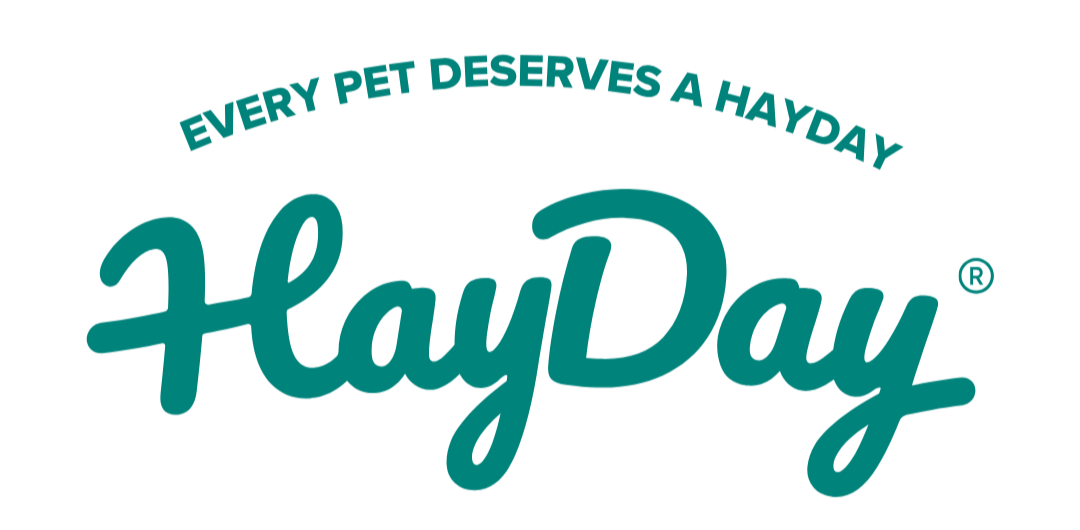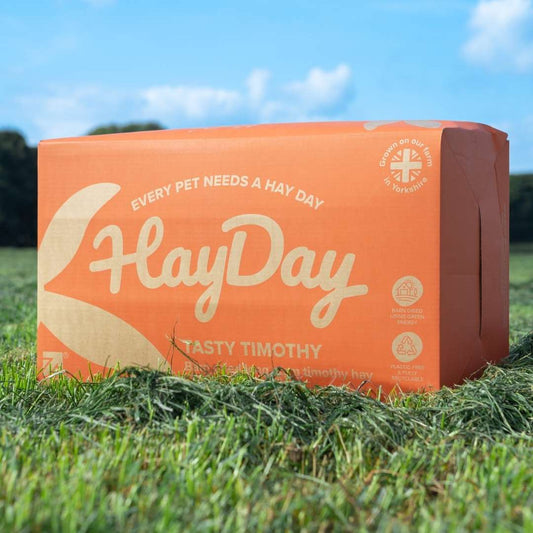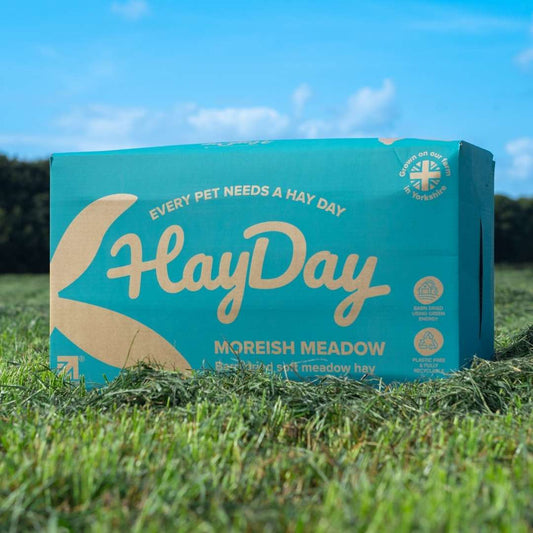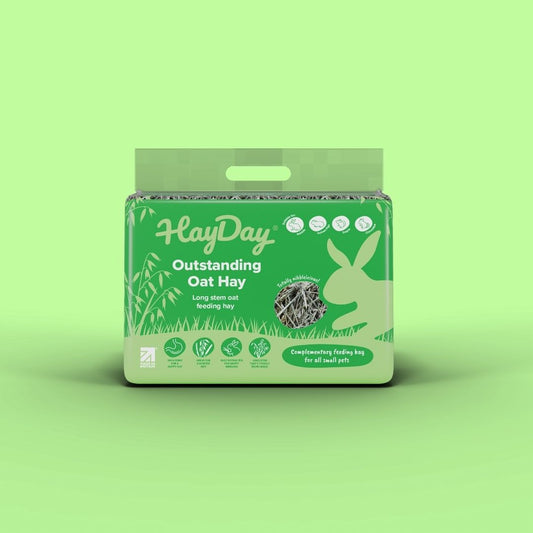If you haven't already decided that buying premium quality hay from HayDay is a good idea, find out more in our hay-mazing guide to: what is hay?
In simple terms, hay is dried grass, typically re-processed into bales for small pets, the equine market or for livestock feed.
But it is also SO much more than that! Within this guide, the experts at HayDay delve into its production, from seed to hay bale, illustrate its importance in a small pet's diet, and conclude “what is hay” once and for all.
Perfect for new small pet owners, hay novices and experts alike, let’s uncover the ins and outs of tasty hay.
Click here > For premium, barn dried hay boxes for small pets.
What is Hay? Quick Overview
-
Hay is a highly nutritious dried grass product fed predominantly in the diets of small pets such as rabbits, guinea pigs, chinchillas and degus.
-
It is distinctly different from straw, which is typically made from wheat, barley and oil seed rape (not grass) and serves primarily for bedding, with a lower nutritional value.
-
Producing grass (hay) involves a skilled process involving mowing, tedding, baling, drying and proper storage conditions to maintain its nutritional content over time.
-
Aside from feeding small pets, equine and livestock markets, hay serves a range of practical uses too that includes: animal bedding, erosion control, mulching in gardening, and as a biomass resource for energy production.
How Is Hay Made?
There are many different types of hay, but at its core, hay is dried grass, harvested and processed for use as animal forage. Hay is made with a meticulous farming process that involves:
Hay Making Process
-
Drilling: Planting premium grass mixes (during Autumn) which include Timothy, Meadow, Ryegrass and many more!
-
Growing: After drilling the seeds, the grass grows! Typically we can expect a first cut of hay in early May and June (weather dependent).
-
Mowing: Once the grass is ready (usually on a nice and sunny day), we cut it with our huge mowers.

-
Tedding: Once the grass is cut and is on the floor, it is 'turned', also know as tedding. Tedding helps to let the air and sun get to the grass in order to dry it. This process is vital in drying the grass - turning the grass to hay.
-
Drying (Either field dried or barn died): Some farming methods include leaving the hay to field dry where you rely on consecutive sunny days. At HayDay, when needed, we barn dry our grass (hay) using green energy and sustainable technology in order to get perfect quality hay each time, all year round.
-
Baling: The hay is then baled, ready for storage and for customers and their pets to enjoy.
These stages of harvest are super important when it comes to:
-
The quality of the product produced
-
Preserving the key nutrients within the product
-
The volume of hay that can be produced
What is hay used for?
Hay is mainly used as the main forage source for small animals such as rabbits, guinea pigs, chinchillas, degus, plus livestock like horses, cows, goats and sheep.
Besides feeding animals, hay can also be used as bedding, as mulch in gardens, or even as a biomass resource to produce energy in sustainable farming.
Defining Hay: More Than Just Dried Grass
Hay is more than just simple dried grass; it should from 80 to 90% of any small pet diet.
As a rich source of vital nutrients for animals, as well as supporting their dental and digestive systems, grass is harvested whilst green and dried naturally in the field or barn dried.
The drying process is the most important part of the process for preserving its nutritional content, green colour and perfect texture for your furry friends.
Drying hay minimises the loss of starches and sugars, thereby preserving more dry matter and total digestible nutrients in the cut hay forage.
The nutrients present in hay are numerous, including:
-
Calcium
-
Carbohydrates
-
Crude Protein
-
Crude Fibre
-
Fats
-
Minerals
-
Vitamins
-
Water
-
Zinc
Hay Nutritional Profile
Hay is highly nutritious, making it an essential source of food for many animals, especially small pets! By feeding a high quality hay, this will support your small pet's digestion and dental health, helping to prevent any potential health issues.
Next, we will identify the animals that consume hay and determine how to match the type of hay to their dietary requirements.
What Small Pets Eat Hay?
Many animals eat hay, but the ones that benefit the most are small pets such as:
These animals rely on the quality of hay produced, in order to meet their nutritional needs.
How do I know which hay to choose?
Not all hay types are appropriate for every type of animal. For instance, Timothy Hay and Meadow Hay are extremely beneficial for small pets such as: rabbits, guinea pigs, chinchillas and degus due to the high fibre content.
Alfalfa Hay, on the other hand, is better suited for growing rabbits (up to 6 months) as well as those that are ill, due to the higher calcium and protein content which aids their growth. After around 6 months, to your vet or nutritionists discretion and depending on your pet, they can move onto Meadow Hay or Timothy Hay.
The Essentials of Hay Production
Creating hay is a detailed process that includes the following steps:
-
Mowing the grass.
-
Tedding (also known as turning) in order for the grass to dry in the sun and turn into hay.
-
Raking the dry hay into rows.
-
Baling the hay into either round or square bales, depending on the specific needs of the farmer.
Ideal weather conditions for hay production are characterised by extended periods of dryness with abundant sunshine and light winds. Too much rain can significantly impede the harvest process.
Having covered the fundamentals of hay and its production, we can now distinguish it from straw, which is often misinterpreted as hay.
Hay vs. Straw: Understanding the Difference
While hay and straw may look similar and are both often processed into bales, the differences between hay and straw come down to their nutritional content and uses.
Hay is primarily used as animal feed due to its high nutritional value. On the other hand, straw, with its low nutritional content and coarser texture, is predominantly used for bedding: for small pets, horses and livestock.
The production process for straw is comparatively less intricate than that of hay - albeit it's not necessarily easier. Straw is derived by first harvesting the grain (wheat, barley, oil seed rape), followed by baling the remaining stalks.
Barley and wheat are two of the most popular varieties of crops used for straw production.
The Journey from Grass Seeds to Hay Bale
From drilling the seeds in autumn to baling the finished product, the production of hay is a meticulous process. The journey starts in the fields, where seeds of specific grass or legume varieties are sown.
These crops are cultivated and nurtured until they reach maturity, an important factor in ensuring premium hay quality. The timing of harvest has a significant impact on the forage quality and yield of hay too.
Once mature, the crops are cut, dried, and eventually baled. The bales are then transported (carted) from the field to the farm for storage. Proper storage is essential to maintain the quality of hay and prevent any spoilage.
Moving on, we will examine each stage of this process in detail.
Cultivating Hay Crops
Cultivation is the first step in the hay production process. The seeds are drilled at the optimal time, typically in the Autumn.
Below are some popular varieties of hay for small animals:
-
Alfalfa hay (more formally known as Lucerne)
-
Orchard Grass
These types are the preferred forage option for small pets due to their well-balanced nutrient content and widespread availability in the UK and worldwide.
Harvesting Hay: Timing and Techniques
Harvesting is a critical stage in hay production. The timing of harvest plays a significant role in the quality of the final product.
Harvest is dependent on the grass product sown.
The nutritional content and therefore how appropriate it might be for an individual, will also vary significantly depending on the growth stage of the grass and environment at the point of harvest.
As such, Ryegrass Hay is typically the first to be harvested, followed by Timothy Hay and then Meadow.
Due to the demand for premium quality hay, all year round - the machinery and techniques used in the harvesting process have evolved over time too! From manual labour to technologically advanced equipment.
Modern harvesting machines and methods used are:
-
Balers
-
Mowers
-
Rakes
-
Tedders
Next, we focus on the subsequent step - storing the harvested hay.
Storing Hay Bales Properly
Once harvested, the hay bales are carted from the field to the farm for storage. Proper storage is required to maintain the nutritional quality of hay throughout the time that its stored.
In order to store hay correctly, it must:
-
Be out of direct sunlight
-
Have access to adequate airflow
-
Be in a cool, dry conditions
Challenges in Hay Making: Weather's Role
Weather plays a significant role in hay production, with rain posing potential problems. Rain can significantly impede harvesting the hay and the quality of hay subsequently produced.
To safeguard the hay from weather-related obstacles, farmers use the following techniques:
-
Use weather forecasting to schedule the harvest
-
Invest in barn drying facilities to aid the drying process and guarantee quality product
At HayDay we use green energy to power our drying sheds, rather than relying on the British, inclement weather! So when the weather isn't on our side, we can still guarantee great quality, premium hay products all year round for your small pets.
Summary
This guide takes you through the process from the field to bale, uncovering the fascinating world of this seemingly ordinary grass product.
We’ve learned how hay is far more than just dried grass, with a rich nutritional profile that feeds a variety of animals. We’ve discovered the intricate process that turns grass into nutritious bales of hay, and the modern methods of harvesting that have revolutionised this process.
But perhaps the most important take-away from our journey is the realisation of how important hay is to our pets daily lives.
So, the next time you see a hay bale, remember, it’s more than just dried grass - it’s a popular, and vital, forage product for small pets that aids them to live happy and healthy lives.
Relevant Links
Timothy Hay vs Ryegrass Hay: The difference & feeding tips
Types of Hay for your Small Animals
Frequently Asked Questions
Is hay a straw or grass?
Hay is a type of grass, the most popular variety being Timothy Hay. Which is cut and dried to be used as animal feed.
What is hay and how is it made?
Hay is a food source for animals, made from dried grasses or legumes. It is cut and baled at the peak of nutritional value and fed to small animals, horses or livestock.
What is difference between hay and straw?
Hay is a crop grown for animal forage, while straw is a byproduct of grain crops, such as wheat. This differentiation helps in understanding their purposes in agricultural practices.
What animals are commonly fed hay?
Livestock such as cows, horses, sheep, and goats commonly feed on hay, as well as small animals (rabbits and guinea pigs). However, not all hay types are suitable for every animal.





